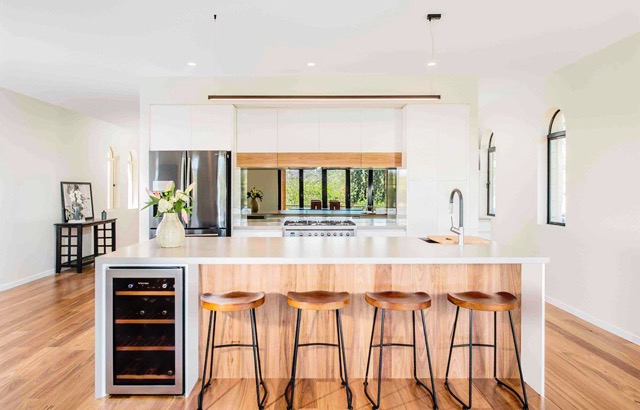Renovation is an exciting and daunting adventure
Whether you're revamping your kitchen, updating your bathroom, or considering a whole-home makeover, home renovating requires careful planning, diligent research, and a keen eye for design details. It's a realm where function meets aesthetic, and where the satisfaction of a job well done can resonate for years to come.
For industry expert information, who better to learn from than James Treble, renowned figure in the home design and renovation. With his vast experience and stellar track record, his insights are essential for anyone looking to improve their home.
Step One: Begin with a Strong Foundation
Every renovation starts with an idea, a vision of what your living space could look like. But before you begin tearing down walls, it’s crucial to have a solid plan in place. James Treble emphasises the importance of doing your homework.
Plan Your Renovation Project
Outline the scope of your project. What do you want to achieve? Understanding your end goals will shape all decisions going forward. Think beyond just aesthetics; consider functionality and energy efficiency in your plans.
Work with a Designer or Architect
Nothing beats the professional input of a designer or architect. They can help you to refine your vision, make the most of your space, and ensure that the end result is not only beautiful but also structurally sound and meets all regulations.
Set a Realistic Budget
Dreaming big is wonderful, but you need to be realistic about what you can afford. Allocate funds for unexpected costs, as they often come up. Remember, quality items generally have a higher price tag but can save money in the long run due to longevity and lower maintenance costs.
Obtain Necessary Permits
Depending on the scale of your renovations and your location, you may need permits for certain types of work. Check with your local council before you start. It will save you a lot of headaches down the road.
By starting on the right foot, you’ll set a foundation that can support the weight of your project from start to finish.


Step Two: The Importance of Quality
James firmly believes in the value of quality over quantity when it comes to home renovations. Renovating is an investment in your home, and cutting corners can lead to costly repercussions.
Invest in Good Quality Materials
Quality materials stand the test of time. They age well, require less maintenance, and hold their value. Always opt for the best you can afford, especially when it comes to things like cabinetry, flooring, and fixtures.
Do Not Compromise on Workmanship
Even the best materials will perform poorly if not installed correctly. Skilled, professional tradespeople are worth their weight in gold. Look for recommendations, check references, and verify their experience level.
Prioritise Functional Design
A beautiful design is important, but functionality is key. A well-designed space that suits your needs and lifestyle will be a joy to use every day. Consider the flow of the room, the placement of appliances and furniture, and how you move within the space.
We often associate quality with higher costs, but in the home renovation arena, quality investments pay off in the long term.
Step Three: Lighting and Color
Lighting and color are powerful tools in the renovation process. They can manipulate perception, affect mood, and transform any room.
Maximising Natural Light
Natural light is always in style. Where possible, maximize the use of daylight by optimizing window placement and scaling back any obstructions.
Strategic Lighting Solutions
In spaces where natural light is limited, a well-considered lighting plan is crucial. Layering different types of lighting—ambient, task, and accent—can create the right atmosphere for any occasion.
Choosing the Right Colours
Color has a profound impact on the feel of a room. Lighter colors can make a space feel larger and brighter, while darker hues can create a more intimate atmosphere. Choose colours that resonate with you, but also consider the function of the room and how different colours can complement the space.
Read more about the psychology of colour and how to can work with your space
Good lighting and a thoughtful color palette are like the icing on the cake, completing the picture of your perfect renovated space.
Step Four: The Fine Details
It’s often the small details that make the biggest difference in a renovation. They add character, reflect your personal style, and can turn a good renovation into a great one.
Focus on Details that Matter
From the door handles to the crown molding, make sure that every detail counts. Choose elements that enhance the overall look and feel of the space.
Storage Solutions
Incorporate clever storage solutions into your renovation plans. Think about built-in cabinetry, under-stair storage, and other smart options that can help keep your space clutter-free.
Personal Touches
Renovations are personal, so don’t forget to include elements that speak to you. Whether it’s a unique feature wall, a piece of art, or a family heirloom, these personal touches can make your space feel truly yours.
In the end, it’s the sum of these details that can elevate your home to new levels of comfort and style.

James Treble's words of wisdom are not just for the moment of project inception but for every decision you make throughout the renovation process.
For those seeking more inspiration and practical advice, there's no better place to start than the Home Show, where experts and novices alike can find tools, materials, and fresh ideas. It is a hub for all things renovation, promising to facilitate the transformation of your house into a dream home.
If you're ready to turn your renovation dreams into reality, grab a ticket for the upcoming Home Show and prepare for three days of renovation and building fun. It's an investment of time that can save you time in the long run, ensuring a smoother renovation process and a truly satisfying outcome. Your dream home awaits—start planning and make it happen.
Image Credit: James Treble



